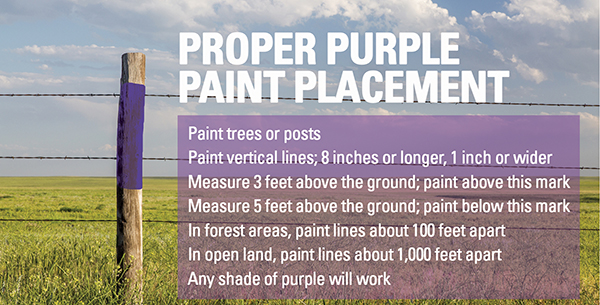Protecting Against Trespass

2024 Spring Antiques Show | March 14 – 31
2024 Fall Antiques Show | October 10 – 27


Thanks to the unusually high rainfall that much of Texas received earlier this year, it’s a good bet your stock tank is full of water. Is it also full of fish that might tempt someone to come try their luck while you’re diligently working in town during the week?
Reasonable people respect private property rights and would never trespass. But just in case trespassers are tempted to stray onto your land, there are some things you can do as a landowner to indicate your property is yours and entry is by your invitation only.
The Texas Penal Code, Section 30.05, was amended in 1997 to specify these five methods a landowner can use as No Trespassing notices:
Change your locks
“When you’re out on your land, just enjoying the green grass or getting ready for hunting season this fall, go ahead and change all the locks on your gates,” said Larry Gray, executive director of law enforcement for Texas and Southwestern Cattle Raisers Association (TSCRA).
Thieves may trick a landowner by placing a look-alike lock of their own on the gate giving them easy access to equipment, country homes, vehicles and livestock, he said. By replacing all the locks all the way around the property at least once a year, you make your ranch more difficult to enter.
If you lease your land for hunting or fishing, or invite guests to hunt or fish at their leisure, give each lessor or guest their own key to the lock on the gate you want them to use for entry and exit. Once their visit is over, or hunting season is over, change that lock. Your guests or lessors might not return any time soon, but what might happen to their keys?
“We all know chains and locks on gates can be cut, and when that happens, you know someone has been on your property, and you can assess what’s been stolen,” Gray said. “If the thief has his or her own lock on your gate, you won’t know when they’ve been there.”
Control the locks on your gates, and make your ranch unappealing to thieves.
Keep a remote eye on things
Thanks to better technology and a pretty thorough network of cell phone coverage, you can keep an eye on your property with a video surveillance system. Systems can range from a game camera that sends a photo to your cell phone to a sophisticated real-time video stream that you can access via the Internet.
Gray said some TSCRA members have installed game cameras at ranch gates. The motion of opening and closing the gate triggers the camera capturing an image of all who enter and exit.
“You can make the game cameras as obvious or as hidden as you want,” he said.
Obvious surveillance may deter trespassers. Hidden cameras will, of course, be less likely to be damaged by trespassers. Either way you go, you’ll capture an image that can be used to press charges against a trespasser.
Contact your local law enforcement if someone trespasses on your land. TSCRA special rangers will be glad to offer advice and suggestions on trespass cases and will investigate agricultural theft after local law enforcement has been informed of the crime.
TSCRA has 30 special rangers stationed strategically throughout Texas and Oklahoma who have in-depth knowledge of the cattle industry and are trained in all facets of law enforcement. All are commissioned as special rangers by the Texas Department of Public Safety and/or the Oklahoma State Bureau of Investigation.
TSCRA, formed in 1877, is the largest and oldest livestock organization based in Texas.
by Ellen Humphries Brisendine
Texas and Southwestern Cattle Raisers Association
Photos by Special Rangers Robin Clark and Howard Brittain
2024 Spring Antiques Show | March 14 – 31
2024 Fall Antiques Show | October 10 – 27